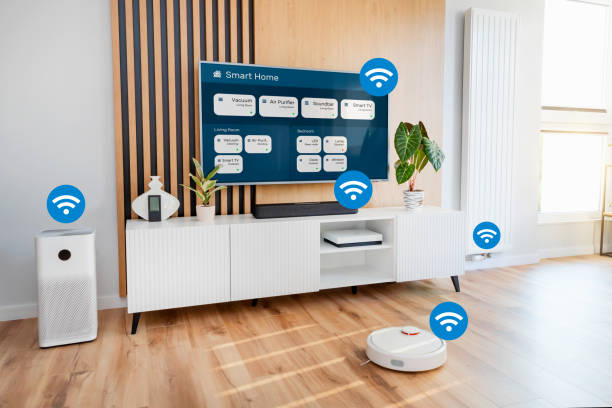Moving to a new home brings excitement and a fresh start, but it also comes with the task of setting up essential utilities, including Wi-Fi and many more. A reliable and efficient Wi-Fi connection is crucial in today’s interconnected world, powering everything from entertainment to work. Well, if you are the one who just moved to a new house, this guide is for you. In this comprehensive guide, we’ll walk you through the process of how to set up your Wi-Fi after moving to a new home, ensuring seamless connectivity throughout your living space. Let’s start!
Introduction
Upon moving to a new home, one of the first tasks on your to-do list should be setting up your Wi-Fi network. Whether you’re streaming movies, attending virtual meetings, or simply browsing the web, a stable internet connection is indispensable. By following the steps outlined in this guide, you’ll be able to configure your Wi-Fi network with ease, ensuring optimal performance and coverage.
Assessing Your Wi-Fi Needs
Before diving into setting up your Wi-Fi network, it’s essential to take some time to assess your specific requirements. Understanding your Wi-Fi needs will help you make informed decisions when choosing equipment and configuring your network. Here are some key considerations to keep in mind:
Home Layout: Take note of the layout of your new home. Consider factors such as its size, the number of floors, and any obstacles that may affect Wi-Fi signal propagation, such as walls or large furniture.
Number of Devices: Make a list of all the devices that will connect to your Wi-Fi network. This may include smartphones, laptops, tablets, smart TVs, gaming consoles, smart home devices, and more. Be sure to account for all devices that require internet access.
Bandwidth Requirements: Determine the bandwidth requirements of your household. Are you primarily using the internet for basic web browsing and email, or do you regularly stream high-definition video, participate in online gaming, or work from home? Understanding your bandwidth needs will help you choose an appropriate internet plan and router.
Future Expansion: Consider any future expansion plans that may impact your Wi-Fi network. Will you be adding more devices to your network in the future? Are there any upcoming renovations or additions to your home that may affect Wi-Fi coverage? Thinking ahead will ensure that your Wi-Fi setup remains scalable and future-proof.
Choosing the Right Router
Selecting the appropriate router is a critical step in setting up your Wi-Fi network. With a wide variety of routers available on the market, it’s essential to consider several factors to ensure you choose one that meets your specific needs. Here are some key considerations to keep in mind:
Home Size: The size of your home plays a significant role in determining the type of router you need. Larger homes may require routers with stronger signal coverage to ensure all areas receive reliable Wi-Fi connectivity.
Number of Devices: Take into account the number of devices that will be connected to your Wi-Fi network. If you have numerous devices accessing the internet simultaneously, such as smartphones, tablets, laptops, smart TVs, and smart home devices, you’ll need a router that can handle multiple connections without sacrificing performance.
Speed and Performance: Consider your internet usage habits and the speed requirements of your household. If you frequently stream high-definition video content, engage in online gaming, or work from home, you’ll want a router capable of delivering fast and reliable Wi-Fi speeds to accommodate these activities.
Advanced Features: Consider whether you require any advanced features or functionalities from your router, such as beamforming technology for improved signal strength, MU-MIMO (Multi-User, Multiple Input, Multiple Output) for simultaneous data streaming to multiple devices, or Quality of Service (QoS) for prioritizing certain types of internet traffic.
Budget: Finally, establish a budget for your router purchase. While it’s tempting to opt for the latest and most expensive model, it’s important to choose a router that strikes the right balance between performance and affordability for your specific needs.

Positioning Your Router
The placement of your router within your home is crucial for ensuring optimal Wi-Fi coverage and performance. By strategically positioning your router, you can minimize signal interference and maximize coverage throughout your living space. Here are some key tips for positioning your router:
Central Location: Place your router in a central location within your home to ensure that Wi-Fi signals are evenly distributed throughout. Ideally, the router should be placed on a high shelf or mounted on a wall to maximize coverage.
Elevated Position: Position the router at an elevated location, such as on the second floor of your home, to allow for better signal propagation. Avoid placing the router on the floor or behind large objects, as this can obstruct the Wi-Fi signal and reduce coverage.
Avoid Obstructions: Keep the router away from obstructions such as walls, furniture, and large appliances that can interfere with Wi-Fi signal transmission. Thick walls, metal objects, and electronic devices can all disrupt the signal and create dead zones within your home.
Minimize Interference: Avoid placing the router near other electronic devices that operate on the same frequency, such as cordless phones, microwave ovens, and baby monitors. These devices can cause interference and degrade Wi-Fi performance.
Consider External Factors: Take into account external factors such as neighboring Wi-Fi networks and environmental conditions when positioning your router. Use a Wi-Fi analyzer tool to identify the least congested channels and adjust your router settings accordingly.
Use Signal Boosters: If you have a large home or encounter Wi-Fi dead zones in certain areas, consider using signal boosters or Wi-Fi extenders to extend coverage. These devices can amplify the existing Wi-Fi signal and improve coverage in hard-to-reach areas.
| Call 866-861-4084 for Internet Deals |
Setting Up the Router
Once you’ve chosen the right router for your needs and found the perfect location for it within your home, it’s time to set it up. Setting up your router involves several steps to configure basic settings and establish a secure Wi-Fi network. Follow these step-by-step instructions to get your router up and running:
Unbox and Connect: Start by unboxing your router and connecting it to a power source using the provided power adapter. If your router has external antennas, attach them securely to the designated ports.
Connect to Modem: Use an Ethernet cable to connect your router to the modem provided by your internet service provider (ISP). Insert one end of the Ethernet cable into the WAN port on the router and the other end into the Ethernet port on the modem.
Access Router Interface: Connect your computer or mobile device to the router either wirelessly or via Ethernet cable. Open a web browser and enter the router’s default IP address (e.g., 192.168.1.1) in the address bar. You can find the default IP address and login credentials in the router’s user manual or on the manufacturer’s website.
Login and Configure: Enter the default username and password provided in the router’s documentation to access the router’s web interface. Once logged in, follow the on-screen instructions to configure basic settings such as the network name (SSID) and password for your Wi-Fi network.
Test Connectivity: Once you’ve configured the router settings, disconnect your computer or mobile device from the router and connect to the Wi-Fi network using the new SSID and password. Test the connectivity by browsing the web and streaming content to ensure everything is working correctly.
Configuring Wi-Fi Settings
After setting up the router, it’s crucial to configure Wi-Fi settings to ensure security and optimal performance. Choose a unique and secure network name (SSID) and password to prevent unauthorized access. Additionally, explore advanced settings such as channel selection and Quality of Service (QoS) to fine-tune your Wi-Fi network for better stability and speed.

Testing and Troubleshooting
Once your Wi-Fi network is up and running, it’s essential to test its performance and address any issues that may arise. Use a Wi-Fi analyzer app to check signal strength throughout your home and identify potential dead zones. Common troubleshooting steps include rebooting the router, updating firmware, and adjusting settings to minimize interference.
Securing Your Wi-Fi Network
Protecting your Wi-Fi network from security threats is paramount. Enable WPA2 or WPA3 encryption to encrypt data transmitted over the network and prevent unauthorized access. Additionally, regularly update your router’s firmware and change the default admin password to thwart potential attacks.
Optimizing Wi-Fi Performance
To optimize Wi-Fi performance, consider implementing various techniques such as channel optimization, device prioritization, and signal strength optimization. Additionally, keep your router firmware up to date and periodically reboot the router to refresh its settings and maintain stability.
The Importance of a Reliable Home Network
In today’s digital age, a reliable home network is more than just a convenience—it’s a necessity. From remote work and online education to entertainment streaming and smart home devices, virtually every aspect of modern life relies on a stable internet connection. Understanding the importance of a reliable home network can help you appreciate the value of investing in quality networking equipment and ensuring seamless connectivity within your home.
1. Work From Home
With the rise of remote work opportunities, many professionals now rely on their home internet connection to stay productive and connected with colleagues. A reliable home network ensures that you can participate in virtual meetings, access cloud-based resources, and collaborate on projects without experiencing interruptions or connectivity issues.
2. Online Education
The shift towards online learning platforms has made a dependable home network indispensable for students of all ages. Whether attending virtual classes, accessing educational resources, or submitting assignments online, a stable internet connection is essential for facilitating uninterrupted learning experiences.
3. Entertainment Streaming
Streaming services such as Netflix, Hulu, and Disney+ have revolutionized how we consume entertainment content. However, streaming high-definition videos and multimedia content requires a robust internet connection with sufficient bandwidth to support smooth playback without buffering or interruptions.
4. Smart Home Devices
The proliferation of smart home devices, including smart thermostats, security cameras, and voice-activated assistants, has transformed modern living. These devices rely on a reliable home network to communicate with each other and with cloud-based servers, enabling seamless automation and remote control capabilities.
5. Gaming
Online gaming enthusiasts depend on low-latency connections and stable network performance to enjoy immersive gaming experiences without experiencing lag or latency issues. A reliable home network ensures that gamers can compete online, download updates, and stream gameplay without disruptions or delays.
| Call 866-861-4084 for Internet Deals |
6. Communication and Social Connectivity
From video calls with family and friends to staying updated on social media platforms, communication and social connectivity are integral parts of daily life. A dependable home network enables seamless communication, allowing you to connect with others, share updates, and stay connected regardless of physical distance.
7. Internet of Things (IoT) Integration
As the Internet of Things (IoT) continues to expand, more devices are being interconnected and integrated into our homes. From smart appliances and lighting systems to wearable devices and health monitors, these IoT devices rely on a stable home network to function efficiently and communicate with other devices and servers.

Conclusion
Setting up your Wi-Fi after moving to a new home may seem daunting, but with the right approach and guidance, it can be a straightforward process. By assessing your needs, choosing the right equipment, and following best practices for setup and optimization, you can create a reliable and efficient Wi-Fi network that meets your household’s demands.
FAQs
How do I know which router is best for my home?
Consider factors such as home size, number of devices, and desired speed and range. Research different router models and read reviews to find one that meets your needs.
What should I do if I experience Wi-Fi dead zones?
Try repositioning your router to a more central location or consider using Wi-Fi extenders or mesh systems to extend coverage.
Is it necessary to change the default Wi-Fi network name and password?
Yes, changing the default network name (SSID) and password is recommended to enhance security and prevent unauthorized access.
How often should I update my router firmware?
It’s a good practice to check for firmware updates regularly and install them as they become available to ensure your router is protected against security vulnerabilities and performance issues.
Can I set up parental controls on my Wi-Fi network?
Many routers offer parental control features that allow you to restrict access to specific websites or set time limits for internet usage. Check your router’s manual or web interface for options to configure parental controls.

Meet Jennifer Harper, a wordsmith extraordinaire who has been shaping the digital landscape with her creative prowess for the past two years. Not just a content writer; she is a storyteller who brings the content to life. Her passion for internet trends, memes, and the ever-evolving world of entertainment is evident in every piece she creates. Jennifer doesn’t just follow trends; she sets them.